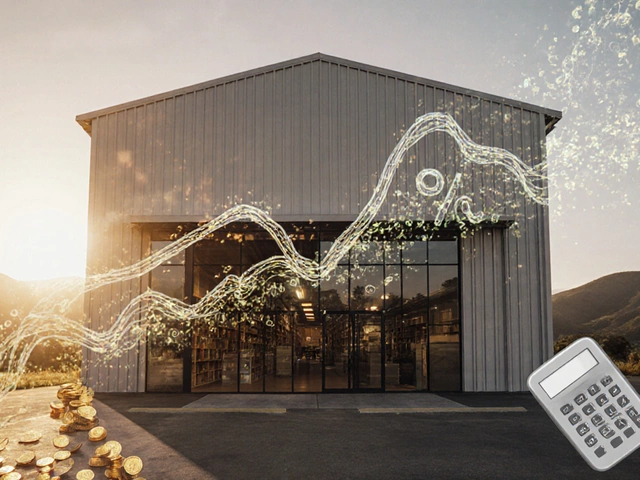Understanding a 7.5% Cap Rate in Commercial Property Sales

Ever found yourself scratching your head over real estate jargon? You're not alone. A common term that pops up in commercial property sales is the 'cap rate.' So, what does a 7.5% cap rate mean, really? It's all about potential returns. This percentage helps investors figure out how much they might earn from a property yearly. Imagine buying a property in Auckland and expecting that return annually if you bought it completely with cash. Sounds intriguing, right? But hold on, there's more to it than meets the eye.
Diving a bit deeper, the cap rate is about comparing potential investments. Is a 7.5% cap rate good? It depends. That's where the investor's goals come into play. Are they looking for steady income or quick cash? Different cap rates tell us about different risk levels and market conditions. So, when you're considering a commercial property, always keep the cap rate in your back pocket. It’s not just a number—it’s a tool for making smart decisions.
- What is a Cap Rate?
- How to Calculate Cap Rates
- Significance of a 7.5% Cap Rate
- Comparing Cap Rates
- Tips for Investors
What is a Cap Rate?
Alright, let’s break it down. A cap rate, or capitalization rate, is a metric that real estate investors use to gauge the potential return on a commercial property. Think of it like a snapshot that helps you understand the financial return you'd get if the property is bought outright without a mortgage. Simple, right? It's often expressed as a percentage, like the 7.5% cap rate we’re exploring today.
To put it plainly, the cap rate is calculated by dividing the property's net operating income (NOI) by its current market value. Here’s a neat little formula:
Calculating Cap Rate
The formula looks like this:
- Net Operating Income (NOI): This is the total income generated from the property minus any operating expenses.
- Property Value: This is the current market value of the property.
Cap Rate = NOI / Current Market Value
So, if a building generates $75,000 in annual net income and is valued at $1,000,000, it would have a cap rate of 7.5%. Simple math, but super insightful.
“Cap rate reflects the risk-free rate, real estate’s risk premium, and growth expectations,” explains John Williams, a veteran real estate analyst.
This means the cap rate not only tells you about the potential return but also hints at the level of risk compared to other investments. It’s like reading between the lines of what the real estate market is whispering to you.
Cap rates can reveal a lot about the property's financial health. A high cap rate might suggest higher risk but potentially higher returns, while a low cap rate might indicate a safer investment with lower returns.
Knowing your cap rates can help guide your investment strategy in the commercial property world, making sure you're not blindsided by unexpected returns or risks.
How to Calculate Cap Rates
So, you're interested in diving into the world of commercial property investment, huh? One of the first things you'll want to wrap your head around is how to calculate the cap rate. It's easier than it sounds, and trust me, it’s key to making smart decisions in the realm of real estate investment.
Understanding the Basic Formula
The formula is pretty simple:
Cap Rate = (Net Operating Income / Current Market Value) x 100
Sounds straightforward, right? Let's break that down a bit further.
Breaking Down the Elements
- Net Operating Income (NOI): This is all the income a property generates annually after operational expenses, but before taxes and interest payments. Think of it as your property's 'take-home pay.'
- Current Market Value: This is basically what the property is worth right now, if you were to buy it.
Okay, let’s say you own a property in Auckland with a net income of $75,000 a year. If the property is valued at $1,000,000, you’d plug those numbers into the formula:
Cap Rate = ($75,000 / $1,000,000) x 100 = 7.5%
When and Why to Use This Calculation
This little formula can do wonders—it helps you measure the profitability of a property quickly. Investors use it to decide if a property is worth the risk, compares well to other investments, or simply fits into their overall financial strategy.
Common Pitfalls
While cap rates are handy, they don’t tell the whole story. Always cross-check with other data like property trends or maintenance costs. Real estate is dynamic, so relying solely on cap rates could lead you astray.
Now, doesn't that make things a bit clearer? Knowing how to calculate and interpret cap rates can make a world of difference, whether you’re a newbie investor or a seasoned pro.

Significance of a 7.5% Cap Rate
Understanding the cap rate of 7.5% can be a game changer for anyone considering a commercial property investment. But why is this number so important? Let's break it down.
A 7.5% cap rate signifies the potential annual return on an investment property if purchased outright, without any financing costs. This helps investors gauge the expected cash flow relative to the price they're paying for the asset. Basically, the higher the cap rate, the higher the potential return on the investment.
Risk vs. Reward
A cap rate can also reflect risk. Typically, a higher cap rate, like 7.5%, might suggest more risk but also the potential for greater rewards. Think of it like this: in a bustling city like Auckland, properties with a cap rate of 7.5% could be in up-and-coming neighborhoods with room for growth, or perhaps they're already in well-established areas but require some TLC or have higher management costs.
Market Comparison
It’s crucial to compare the 7.5% cap rate against other properties in the same market. For instance, if nearby properties have a cap rate of only 5%, this specific property might offer better value. However, it’s important to dig deeper to understand the reasons behind these numbers. Maybe the property has high maintenance costs or unreliable tenants, which could explain its higher rate.
Historical Trends
Looking at historical data, cap rates can inform about past trends and future predictions. For instance, since 2023, the average cap rate in Auckland has fluctuated between 5% and 8%, depending on the location and property type. Keeping an eye on these trends can help in predicting future property values and growth potential.
| Year | Average Cap Rate in Auckland |
|---|---|
| 2023 | 6.5% |
| 2024 | 6.8% |
| 2025 | 7.2% |
In conclusion, a cap rate of 7.5% isn't just a figure; it's a piece of the puzzle. It helps investors gauge the value, potential returns, and risks associated with a commercial property. By considering other factors such as location, market trends, and property conditions, investors can use this information to make well-informed decisions in the real estate investment world.
Comparing Cap Rates
When dabbling in the world of commercial property, understanding how to compare cap rates can be insanely helpful. It's kind of like dating; you want to know what you're getting into before committing. A cap rate mainly measures return and risk. So, what does a 7.5% cap rate tell us?
First off, a 7.5% cap rate is just one piece of the puzzle. It offers a decent balance between risk and return -- not too high, not too low. For investors, this might mean a reasonably stable neighborhood or market. But let's not stop here. Compare it with others around!
How Do They Differ?
Not all properties are created equal. A lower cap rate, say around 4%, might mean you're dealing with a prime location in downtown Auckland. Such properties usually promise lower returns due to their perceived security and stability.
On the other hand, a cap rate climbing above 10% might scream higher risk. Maybe the property’s in an area that needs some development or has higher vacancy rates.
Factors to Consider
- Location: Prime spots often have lower cap rates due to higher demand.
- Market Trends: Keep an eye on what's hot. Do changing rentals affect the rates?
- Property Condition: An older property might offer a better cap rate but could call for more maintenance.
Here's a simple table to illustrate:
| Cap Rate Range | Potential Indicator |
|---|---|
| 3% - 5% | Highly competitive, low risk |
| 6% - 8% | Balanced risk and return |
| 9% - 12% | Higher risk, potentially high returns |
Remember, numbers don't lie, but they also don't tell the full story. Keep your eyes open for more than just a cap rate before sealing the deal.

Tips for Investors
If you're stepping into the world of commercial property investment, there's plenty to chew over, especially when it comes to cap rates. Here's how you can make the most of your investing game.
Do Your Homework
First up, understand the local real estate market. Knowing the difference between cap rates in Auckland versus, say, Wellington, can shape your choices. A quick way to check is by looking at recent sales and talking to local real estate agents who know the neighborhood pulse.
Diversify Your Portfolio
Don't put all your eggs in one basket. Spread your investments across different properties or even areas. A portfolio with mixed cap rates can provide stability and potential growth. Remember, the commercial market can be fickle. Having a mix can cushion you against unexpected shocks.
Cameron Daniels, a renowned real estate advisor, once said, "An educated guess is simply a gamble in disguise. Know your facts before you bet the house."
Evaluate Risk and Return
Sure, a 7.5% cap rate might sound appealing, but what's the catch? Generally, higher cap rates can mean higher risks. Investigate what factors like location, property age, and market trends contribute to this figure. Ask yourself: Are you ready to accept these risks?
Leverage Financing Wisely
Consider how financing impacts your returns. While paying cash might optimize your cap rate, using mortgage leverage might free up funds for other investments. Just be sure to factor in loan costs to avoid nasty surprises down the track.
Stay Updated with Market Trends
Staying in the loop with market trends and economic indicators is vital. Changes in interest rates, for example, can affect property values and cap rates. Regularly tuning into real estate news can help you make strategic decisions.
| City | Average Cap Rate |
|---|---|
| Auckland | 6.2% |
| Wellington | 6.8% |
| Christchurch | 7.0% |
In the end, knowledge is your biggest asset. The more you dig, learn, and adapt, the better you position yourself in the ever-changing realm of commercial real estate. Happy investing!









Write a comment